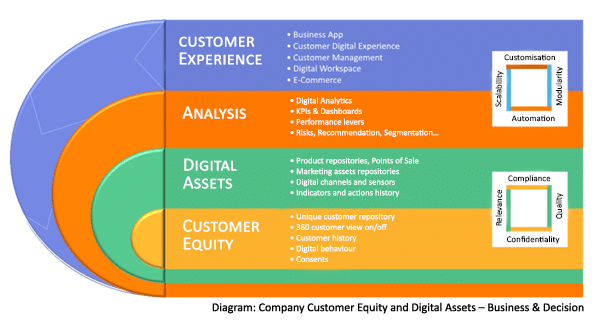At a time when digital transformation projects have been given a boost by the worldwide lockdown situation and the need to develop remote collaboration as well as online sales activities, we feel it would be interesting to propose a new framework for thinking about marketing and sales company data. In this day and age of ad blockers, regulatory constraints, imminent end of 3rd party cookies and customer journey fragmentation, we believe the ability to create a direct relationship with one’s customers, and thus directly collect information, to be critical for companies, making of data collection one of the key components of digital transformation…

It is also highly likely that for at least one year, marketing and advertising budgets will be scaled down, with allocation decisions being closely tied to performance indicators. And in order to generate input for these indicators and improve future lever and marketing campaign performance, in-house data collection and analysis will become a top priority (unless you do not mind depending on major players such as Google and Facebook).
In this context, we recommend paying attention to 2 key fundamentals, illustrated in the diagram below: companies’ Customer Equity and Digital Assets.

Key fundamental 1: Customer Equity
Customer Equity is often described as all known information about customers: profiles, purchases, (digital) behaviour, preferences, etc.
A subject we already touched on in a previous article about cross-functional customer data platforms. It is in fact supported by Customer Data Platforms.
In short, Customer Equity means possessing a unique customer repository and using it to consolidate all Customer information in order to make the relationship history between a brand and its customers traceable.
A word of caution here: it should be understood that customer data is no longer really “owned” by companies: non-anonymised data is only made available by customers for as long as they are willing, and for purposes approved in advance. In the recent 3rd episode of the Martech Show, the expression “VP of Marketing Data” was even replaced by “VP of Customer Information”…
This is why the importance of consent management (consent experience, consent synchronisation, data traceability, privacy centre…) and of establishing a relationship of trust between the brand and its customers should not be underestimated and why entire marketing actions are geared towards building up this capital and ensuring the retention of user rights.
Customer Equity consists theoretically of first-party data (data collected by the company) and zero-party data (data provided by the customer). According to Sharon Forder, in an article published on Forbes.fr, (Marketing VP, Cheetah Digital EMEA), “complementing first-party data, zero-party data is one of the best ways to create customised campaigns that will appeal to consumers, develop a relationship of trust and convert failed marketing attempts into a fertile ground for transformation”.
Key fundamental 2: companies’ digital assets
A company’s Digital Assets include, first and foremost, its own internal repositories and activity history. For instance, without its own product repository, it is difficult for any company to identify coherent customer profiles and to then carry out successful marketing or sales actions (bounce, recommendation, abandoned cart…). Without a history of campaigns that have likely had an impact on customers, global performance analysis would also be incomplete, and you would run the risk of ignoring a major event having the potential to influence customer behaviour…
In addition to this internal data, we think that capitalising on all digital contact points and data sensors at the company’s disposal, in order to generate data for analysis, is also a good idea. Each of the company’s contact points and sensors is included in the digital asset class; a class in which the likes of digital marketing tags coexist with more traditional digital channels owned by the company (email, newsletter, websites…). Current events seem to be proving us right here when you consider WalMart’s project to buy into TikTok in the USA: a move undoubtedly meant to accelerate its transformation through a sales channel that will be under its control (social commerce).
Other examples are available. Such as the deployment of chatbots which constitutes not only a new conversation digital channel or a new customer experience, but also a great data sensor as it is becoming easy today to analyse its conversation and use the metadata (incident, request, mood, origin,…), even anonymously. Through a little IoT, store traffic or queuing time can for their part be measured and archived: an information that can for example help better understand stores’ relative performances.
And what will we do next? Archive “conversations” with smart mirrors, in-store journeys, the path followed by the general public moving along in a shopping area maybe…?
Data collection: 4 key issues
When processes or interactions are digitised, collecting new data becomes easy. Adding a few physical sensors can also help collect data. However, these collection tasks must serve analysis, decision-making and future planning purposes.
For this reason, 4 data issues stand out as being fundamental to us. Keeping them in mind will be one of the keys to the successful development of a direct and efficient customer relationship.
- Collected data Quality (format, completeness, accuracy…)
- Legal Compliance and respecting customer choices/preferences
- Confidentiality, which implies end-to-end security and traceability
- Relevance: we may collect a huge amount of information but is it the most useful information? For example, when trying to find out why a certain store is performing better than another, it sometimes turns out that the most important factors are scarcely measured or not measured at all. Consequently, at enterprise level, and without an objective measure, it is difficult to make significant progress (cleanliness level, exterior signage quality, number of customers in the store…). Creating adequate measuring instruments and… enriching your digital assets have thus become a must.
Some readers could point out that it would also be interesting to use external data such as the weather, local events, the calendar, the competition… and they would be absolutely right. However, as this external data does not, strictly speaking, belong to the company, we have chosen not to mention it as being part of these 2 key fundamentals.
Rather, it will be used within the context of Analysis (orange section of our diagram), to benefit Customer Experience (blue section of our diagram) which is after all the main objective of all IT and marketing projects today.
According to a recent global survey carried out by the IDC firm, 50% of companies in the world have chosen to prioritise customer experience in 2020 and 2021. How about you?
















Your email address is only used by Business & Decision, the controller, to process your request and to send any Business & Decision communication related to your request only. Learn more about managing your data and your rights.